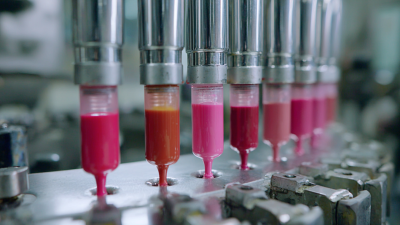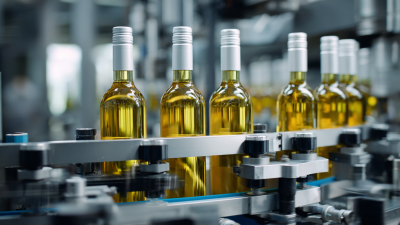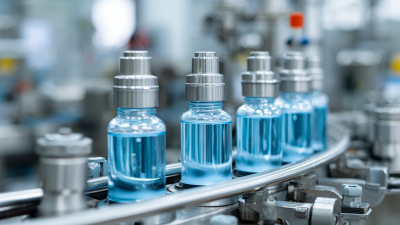2025 Top 5 Syringe Filling Machines You Need to Know
As the pharmaceutical and biotech industries continue to evolve, the demand for efficient and precise syringe filling machines is on the rise. According to a recent market analysis by Grand View Research, the global syringe filling machine market is expected to reach USD 4.67 billion by 2027, growing at a CAGR of 7.8%. This growth is driven by the increasing need for advanced packaging solutions that ensure safety, efficacy, and compliance with stringent regulations.
In this rapidly advancing sector, the operational efficiency of syringe filling machines plays a critical role in meeting production demands while adhering to quality standards. With innovations in automation, technology integration, and easy scalability, modern syringe filling machines offer enhanced capabilities that optimize the filling process.

By examining the top five syringe filling machines set to dominate the market in 2025, we will highlight their unique features, efficiencies, and relevance in today’s pharmaceutical landscape. These insights are essential for stakeholders seeking to invest in reliable and cutting-edge filling solutions that align with industry trends.
Top Features to Look for in Syringe Filling Machines for 2025
When considering syringe filling machines for 2025, several key features stand out that can significantly enhance efficiency and safety in pharmaceutical production. One notable innovation is the capability to handle ready-to-use nested syringes, which streamlines the filling process while reducing contamination risks. Machines that can achieve high output rates, such as those filling up to 400 syringes per minute, are also vital, as they meet the increasing demand within the injectables market.
 Additionally, the advancement of dual chamber syringe filling machines is noteworthy. This technology not only offers the ability to fill complex formulations but is also projected to see significant market growth, reflecting the rising trend for advanced delivery systems in pharmaceuticals. As the industry evolves, businesses will need to invest in these cutting-edge filling machines that provide both agility and precision, ensuring compliance with stringent regulatory standards while addressing the growing needs of the injectables segment.
Additionally, the advancement of dual chamber syringe filling machines is noteworthy. This technology not only offers the ability to fill complex formulations but is also projected to see significant market growth, reflecting the rising trend for advanced delivery systems in pharmaceuticals. As the industry evolves, businesses will need to invest in these cutting-edge filling machines that provide both agility and precision, ensuring compliance with stringent regulatory standards while addressing the growing needs of the injectables segment.
Key Benefits of Automating Syringe Filling Processes
 The automation of syringe filling processes is transforming the pharmaceutical industry, enhancing both efficiency and accuracy. According to a report from MarketsandMarkets, the global market for automated syringe filling machines is expected to reach $1.3 billion by 2025, driven by the rising demand for high-speed and precise manufacturing. Automating these processes reduces human error, increases production speeds, and ensures consistent quality — vital elements in meeting stringent regulatory standards.
The automation of syringe filling processes is transforming the pharmaceutical industry, enhancing both efficiency and accuracy. According to a report from MarketsandMarkets, the global market for automated syringe filling machines is expected to reach $1.3 billion by 2025, driven by the rising demand for high-speed and precise manufacturing. Automating these processes reduces human error, increases production speeds, and ensures consistent quality — vital elements in meeting stringent regulatory standards.
Incorporating advanced technology into syringe filling can yield significant cost savings. A recent study from Grand View Research highlighted that companies utilizing automated systems can decrease labor costs by up to 30% while increasing throughput. This is crucial as pharmaceutical companies look to scale operations to meet rising demand for vaccines and biologics, especially in light of recent health crises.
Tips for Implementing Automation:
- Evaluate your production needs: Not all syringe filling machines are created equal. Assess your volume and product specifications to choose an appropriate solution.
- Invest in training: Ensure your staff is well-trained in operating automated systems to maximize productivity and minimize downtime.
- Monitor performance metrics: Regular assessments of machine efficiency and product quality can help identify areas for further improvement.
How to Choose the Right Syringe Filling Machine for Your Needs
When choosing the right syringe filling machine for your needs, it's essential to consider several factors that can enhance both efficiency and safety in your operations. The growth in demand for prefilled syringes has led to significant innovations, particularly in automating the fill/finish line, which can greatly enhance productivity. Ensuring that your equipment accommodates these advancements will not only streamline operations but also take advantage of cost-effective solutions.
**Tips:** Focus on selecting machines that offer high compatibility with various syringe sizes and types. Look for those that can easily handle high-viscosity drugs, as these increasingly prevalent formulations require precise filling processes. Additionally, prioritize equipment that adheres to best practices for sterility assurance, ensuring safe preparation and administration while minimizing contamination risks.
Investing in the right technology is crucial, particularly as the market for injectable drugs intensifies and competition tightens. Be attentive to the evolving specifications that come with biologics and other advanced therapies, as these can influence the design and functionality required from your syringe filling machines. Always seek manufacturers that stay at the forefront of these trends and offer ongoing support for optimizing your filling operations.
2025 Top 5 Syringe Filling Machines
This chart shows the average filling speed (in units per minute) of the top 5 syringe filling machines available in 2025. Use this information to choose the right machine for your production needs.
Maintenance Tips for Prolonging the Life of Your Filling Machines
When it comes to syringe filling machines, proper maintenance is crucial for ensuring longevity and optimal performance. Regular cleaning is essential; ensure that all components, especially those in contact with liquid, are thoroughly cleaned after each use to prevent contamination and clogs. Additionally, establishing a routine inspection schedule can help identify wear and tear early on, allowing for timely repairs or part replacements that can prevent costly breakdowns.
Lubrication is another key aspect of maintenance. Regularly applying the appropriate lubricants to moving parts reduces friction, minimizing wear and prolonging the machine's operational life. Moreover, keeping the machine in a controlled environment—maintaining stable temperature and humidity levels—can also contribute to its durability. By following these maintenance tips, users can ensure their syringe filling machines operate efficiently and reliably, reducing downtime and increasing productivity in their operations.
Emerging Technologies in Syringe Filling Systems to Watch in 2025
As we approach 2025, the landscape of syringe filling machines is set to evolve significantly, driven by emerging technologies that promise to enhance efficiency, precision, and safety in pharmaceutical manufacturing. One of the key trends to watch is the integration of automation and robotics. Advanced robotic systems are being developed to handle syringe filling processes with minimal human intervention, thereby reducing the risk of contamination and human error. These automated solutions not only improve the speed of production but also ensure consistent fill volumes, which is critical in applications where dosage accuracy is paramount.
Another noteworthy advancement is the incorporation of smart technologies, such as the Internet of Things (IoT) and artificial intelligence (AI). IoT-enabled syringe filling systems can monitor production in real-time, providing valuable data analytics to optimize operations and maintenance schedules. Meanwhile, AI algorithms can be utilized for predictive maintenance, ensuring that machines operate efficiently and reducing downtime. This intelligent connectivity allows manufacturers to adapt swiftly to changing demands and regulatory standards, making their processes more agile and competitive in the fast-paced pharmaceutical industry.
2025 Top 5 Syringe Filling Machines You Need to Know
| Model | Filling Speed (Units/min) | Fill Accuracy (%) | Technology Type | Key Features |
|---|---|---|---|---|
| Model A | 120 | 99.7 | Electromechanical | Automatic cleaning, Adjustable fill volume |
| Model B | 150 | 99.5 | Pneumatic | Compact design, User-friendly interface |
| Model C | 90 | 99.9 | Servo-driven | Minimal waste, High-speed operation |
| Model D | 200 | 98.8 | Robotic | Integrated inspection, High versatility |
| Model E | 110 | 99.6 | Hybrid | Energy-efficient, Remote monitoring |
Related Posts
-

How to Choose the Perfect Lip Gloss Filling Machine for Your Production Needs
-

How to Choose the Right Bottle Labeler for Your Business Needs
-

Exploring Innovative Examples of Capping Machine Technologies in Today's Bottling Industry
-

5 Amazing Tips for Choosing the Right Lotion Filling Machine for Your Business
-

Revolutionizing Packaging: The Unseen Benefits of Automatic Bottle Capping Machines in Modern Production
-

7 Essential Tips for Choosing the Perfect Bottle Labeler






30 Beach Street, Mt Vernon, NY 10550
914-239-3878 sale@bbqmachine.com
© 2025 by TurboFil Packaging Machines, LLC
© 2025 by TurboFil Packaging Machines, LLC


 Skip to content
Skip to content